
Annual Bulletin 3, 1979-1980
Home
Français
Introduction
History
Annual Index
Author &
Subject
Credits
Contact
![]()
![]()
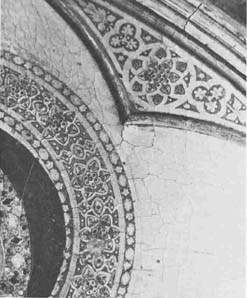
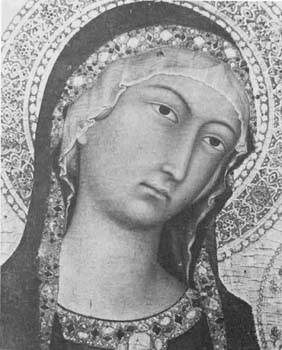
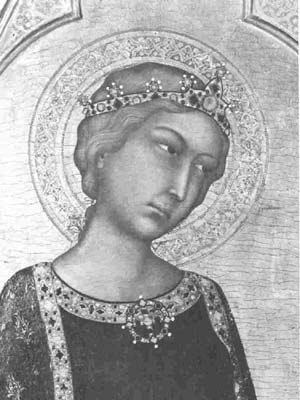
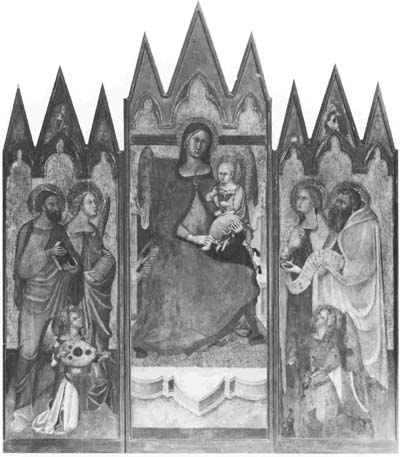
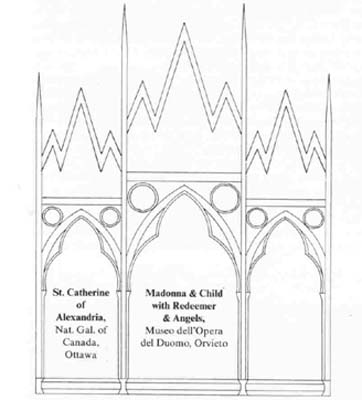
Simone
Martini's St Catherine of Alexandria:
An Orvietan Altarpiece and the
Mystical Theology of St Bonaventure
by Joel Brink
Pages 1
| 2 | 3
| 4
| 5
| 6
| 7
| 8
Moving from the painted and gilded surface to the wooden superstructure,
some observations can be made regarding the trimming and restoration of
the painting's carpentered support. Structural evidence on the back and
along the sides of the panel indicates that the base frame as
well as the two side frames up to the springing of the arch are later
additions. In comparable designs, Simone's carpenter always attached
the base frame to the forward surface of the support, and consequently
when the frame was removed a strip of bare wood was exposed which had
to be removed as well. It is also evident that when the base frame
and its support were cut, a portion of the painted field - including the
tips of the saint's fingers on the right hand - was severed. (Compare the
similar figure from the Isabella Stewart Gardner Museum, Boston, fig. 3.) The new side frames, which were made to conform to the width of the original
arch-frame, were attached to the surface of the panel where the narrow
colonnettes once stood, and this procedure cut off part of the martyr's palm and in the process reduced the width of the painted
field. (5) In addition, a thin slice of wood still inserted into the upper edge of the arch-frame and running continuously from the springing to the apex, reveals that the panel was originally crowned with a pinnacle and possibly an intervening spandril. Simone's carpentry constructions were often tri-layered, and in cases where a pinnacle was to be placed above an arcaded field a separate layer of wood was cut in the shape of the pinnacle and attached to the surface of the support. To establish a smooth transition between the support and the edge of the pinnacle layer, the arch-frame was designed so that the lower edge of the pinnacle could be disguised by being inserted into its upper molding. Later, when the panel was cut along the top of the arch, the portion of the pinnacle
layer which was inserted into the arch-frame was preserved.
The shape of the lost pinnacle could have resembled the triangular form of the similarly-styled panels in the Gardner polyptych (fig. 3). However, there is other evidence to indicate that the pinnacle panel above the painting in Ottawa was even more elaborate in its design. This can be deduced by matching the panel with one of its original companions; for, the St Catherine of Alexandria initially was planned as an integral part of a more complex micro-architectural design. The fully carpentered ensemble, called an altarpiece or tabernacle, would have resembled in miniature a contemporary Gothic church facade with its compartments, pinnacles and pier-shafts all carefully crafted and proportioned. And usually, the altarpiece would have provided an object of contemplation for the observer with the macro-architecture of the church or chapel interior functioning as the backdrop.
Simone Martini and his workshop produced at least four
compartmental altarpieces in Orvieto during the early 1320's: one for the
Dominicans, another possibly for the Augustinians, and two paintings which
have been associated with the Franciscans. (6) One of the Franciscan paintings
bears a striking resemblance to the St Catherine of Alexandria. Once
the central compartment of an altarpiece, it represents the Madonna
and Child with Redeemer and Angels, and is now in the Museo dell'Opera
del Duomo in Orvieto, (Fig. 4). In fact, the panel has been suspected of
being the central compartment of an alterpiece of which the Ottawa St
Catherine provided a flanking panel. (7) Aside from the later serpentine
frame which now surrounds the painting and some minor loss and restoration,
the Orvieto Madonna is in fine physical condition. As in the Ottawa painting,
the base frame and its support have been removed, and the thin spandrel layer,
which is attached to the support continuing upward to provide the pinnacle
field, has been cut out where the original horizontal cornice was attached,
and today the modern frame fits into this notch. (8) The carpentered form
of the panel, including its decorated spandrels and its elaborate tri-gabled
pinnacle, sets this work apart from other altarpieces of the period.
Technical evidence further establishes a common origin and physical
context for the Ottawa and Orvieto panels. The punched patterns in the
arch-cusps, which consist of geometrically expanding six-pointed stars,
are virtually identical in both works of art (fig. 5). The punch-motifs
and the stippling technique employed in the decorative edge of the Madonna's mantle are also identical to that of
St
Catherine. Moreover, the two figures - of the Madonna and St Catherine - are very similar in style and execution (figs 6 & 7): the graceful movement of the heads, the soft treatment of the physiognomy, and the gently flowing hair subtly revealed below the
Virgin's veil in the Orvieto painting - each is a close match in the two
paintings. Finally, the geometrically similar proportions, following the
formula used in Simone's other altarpieces, (9) also confirm that the paintings
were originally integral parts of the same altarpiece. The pose and glance
of St Catherine indicates that the Ottawa panel stood on the left-hand side
of the Orvieto painting, and judging from the general development of the
Sienese altarpiece in the early Trecento, it is probable that the side
compartments duplicated the design of the central panel with roundels in
the spandrils, horizontal cornice and tri-gabled pinnacle above. (10)
This leads to the question of what the complete Orvietan altarpiece
would have looked like. It is unlikely (as C. de Benedictis claims) (11)
that the two paintings in the Berenson Collection, representing St Lucy
and St Catherine, were parts of the original ensemble. Aside from the problem
of including two images of St Catherine in the lateral portion of the same
altarpiece, it is difficult to match up the punch-motifs and the technical
execution of the gold work. For that matter it is difficult to perceive
the hand of the Master Simone in either of these two damaged paintings.
Whereas the physiognomy and graceful articulation of the figures in the Orvieto and Ottawa panels share the same refined qualities as the female figures in the Pisa polyptych, or in the recently-cleaned Gardner altarpiece
(fig. 3), the two Berenson paintings are far less successful stylistically
and should not be considered as parts of the original Orvietan altarpiece.
Moreover, the innovative tri-gabled design and special significance given
to the pinnacle of the Orvieto panel suggests the possibility that
the original altar painting might not have been larger than a triptych.
Repeating the novel shape of the pinnacle two or three times on either side of the central panel would produce an altarpiece awkward for Simone's high standards of design. It is also true that the majority of those altar paintings from the latter part of the fourteenth century that imitate Simone's new pinnacle arrangement, such as that by Bartolo di Fredi in the National Gallery of Umbria, Perugia (fig. 8) are tripartite in
composition. (12) Hence it is reasonable to propose (and the iconography of the painting will support this proposition) that Simone Martini's altarpiece for
the Franciscans of Orvieto was originally conceived as a triptych with tri-gabled pinnacles above each compartment (fig. 9). At the present time, there is no known panel suit able for the right-hand compartment, and hence the identity of the saint opposite St Catherine remains unknown.
Next Page | Simon's
alterpiece at Pisa
1
| 2 | 3
| 4
| 5
| 6
| 7
| 8
Annual Index | Author & Subject | Credits | Contact
This digital collection
was produced under contract to Canada's Digital Collections program,
Industry Canada.
"Digital
Collections Program, Copyright
© National Gallery of
Canada 2001"